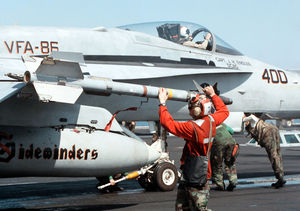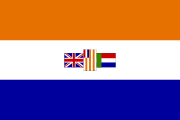AIM-9 Sidewinder
| AIM-9 Sidewinder | |
|---|---|
 An AIM-9 is affixed to an F/A-18 Hornet. |
|
| Type | Short-range air-to-air missile |
| Place of origin | United States |
| Service history | |
| In service | 1956 (AIM-9B) – present |
| Production history | |
| Manufacturer | Nammo Raytheon Company Ford Aerospace Loral Corp. |
| Unit cost | US$85,000 |
| Produced | September 1953 |
| Specifications | |
| Weight | 190 lb (86 kg) |
| Length | 9 ft 4.2 in (2.850 m) |
| Diameter | 5 in (130 mm) |
|
|
|
| Warhead | annular blast-frag |
| Warhead weight | 20.8 lb (9.4 kg) |
| Detonation mechanism |
Magnetic influence (old models) Active infrared (AIM-9L onwards) |
|
|
|
| Engine | Solid-fuel rocket |
| Wingspan | 24.8 in (630 mm) |
| Operational range |
0.6–11.3 mi (1–18 km) |
| Speed | Mach 2.5 |
| Guidance system |
Infrared homing |
| Launch platform |
Aircraft, helicopter gunships |
The AIM-9 Sidewinder is a heat-seeking, short-range, air-to-air missile carried mostly by fighter aircraft and recently, certain gunship helicopters. Variants and upgrades remain in active service with many air forces after five decades. When a Sidewinder missile is being launched, NATO pilots use the brevity code Fox Two in radio communication, as with all "heat-seeking" missiles.
The Sidewinder is the most widely used missile in the West, with more than 110,000 missiles produced for the U.S. and 27 other nations, of which perhaps one percent have been used in combat. It has been built under license by some other nations including Sweden. The AIM-9 is one of the oldest, least expensive and most successful air-to-air missiles, with an estimated 270 kills worldwide to date.[1]
The missile was designed to be simple to upgrade.[2] It has been said that the design goals for the original Sidewinder were to produce a reliable and effective missile with the "electronic complexity of a table model radio and the mechanical complexity of a washing machine"—goals which were well accomplished in the early missiles. The United States Navy hosted a 50th anniversary celebration of its existence in 2002. Boeing won a contract in March 2010 to support Sidewinder operations through 2055, guaranteeing that the weapons system will remain in operation until at least that date. Air Force Spokeswoman Stephanie Powell noted that that due to its relative low cost, versatility, and reliability it is "very possible that the Sidewinder will remain in Air Force inventories through the late 21st century."
The name sidewinder refers to a venomous rattlesnake of the same name, which uses infrared sensory organs to hunt warm-blooded prey.
Contents |
Physics of infrared detection
In the 1920s, it was discovered that exposing lead sulfide to infrared rays (thermal radiation) reduces the compound's electrical resistance. This is an example of a property called photoconductivity; photoconductivity is also seen with illumination by other wavelengths of light[3] (see Ron Westrum's book in reference section). One can measure the resulting current and then link that result to an action—in this case, a seeker head causing the missile to fly toward the heat source (a target aircraft or missile).
Prior to World War II, most of the major forces attempted to produce night-vision systems using lead sulfide detectors and image intensifiers as displays, mostly for long-distance aircraft detection. None of these proved very successful, and only the German "Spanner" system entered production. "Spanner" used a long sighting tube projecting through the aircraft windscreen to give the pilot a view of the air directly ahead of their aircraft, but had limited range. All of these projects ended with the introduction of useful airborne radar sets.
IR detectors found more widespread use for land-based systems. These included everything from sighting systems for tanks and even snipers, to a variety of night driving aids. German scientists also experimented with an automatic missile guidance system intended to home in on the heat of aircraft engines and guide their Enzian missile. It used a single detector located at the focus of a small telescope, with four vanes positioned between the detector and telescope. The telescope "nodded", causing the signal falling on the detector to increase and decrease depending on how much of the signal was being blocked by the vanes. This signal would then be used as an input to a simple autopilot, by continually turning toward the telescope optical axis, the missile was guided toward the target using what is known as a pure pursuit. Development was not complete when the war ended.
History
Early development
The development of the Sidewinder missile began in 1946 at the Naval Ordnance Test Station (NOTS), Inyokern, California, now the Naval Air Weapons Station China Lake, California as an in-house research project conceived by William B. McLean. McLean initially called his effort "Local Fuze Project 602" using laboratory funding, volunteer help and fuze funding to develop what it called a heat-homing rocket. It did not receive official funding until 1951 when the effort was mature enough to show to Admiral William "Deak" Parsons, the Deputy Chief of the Bureau of Ordnance (BuOrd). It subsequently received designation as a program in 1952. The Sidewinder introduced several new technologies that made it simpler and much more reliable than its United States Air Force (USAF) counterpart, the AIM-4 Falcon that was under development in the same time period. After disappointing experiences with the Falcon in the Vietnam War, the Air Force replaced its Falcons with Sidewinders.

The Sidewinder took several design tips from the Enzian, but made a number of innovations that dramatically improved its performance. The first was to replace the "steering" mirror with a forward-facing mirror rotating around a shaft pointed out the front of the missile. The detector was mounted in front of the mirror. When the long axis of the mirror, the missile axis and the line of sight to the target all fell in the same plane, the reflected rays from the target reached the detector (provided the target was not very far off axis). Therefore, the angle of the mirror at the instant of detection estimated the direction of the target in the roll axis of the missile.
The yaw/pitch direction of the target depended on how far to the outer edge of the mirror the target was. If the target was further off axis, the rays reaching the detector would be reflected from the outer edge of the mirror. If the target was closer on axis, the rays would be reflected from closer to the centre of the mirror. Rotating on a fixed shaft, the mirror's linear speed was higher at the outer edge. Therefore if a target was further off-axis its "flash" in the detector occurred for a briefer time, or longer if it was closer to the center. The off-axis angle could then be estimated by the duration of the reflected pulse of infrared.
The Sidewinder also included a dramatically improved guidance algorithm. The Enzian attempted to fly directly at its target, feeding the direction of the telescope into the control system as it if were a joystick. This meant the missile always flew directly at its target, and under most conditions would end up behind it, "chasing" it down. This meant that the missile had to have enough of a speed advantage over its target that it did not run out of fuel during the interception.
The Sidewinder is not guided on the actual position recorded by the detector, but on the change in position since the last sighting. So if the target remained at 5 degrees left between two rotations of the mirror, the electronics would not output any signal to the control system. Consider a missile fired a right angles to its target; if the missile is flying at the same speed as the target it should "lead" it by 45 degrees, flying to an impact point far in front of where the target was when it was fired. If the missile is traveling four times the speed of the target, it should follow an angle about 11 degrees in front. In either case, the missile should keep that angle all the way to interception, which means that the angle that the target makes against the detector is constant. It was this constant angle that the Sidewinder attempted to maintain. This "proportional pursuit" system is very easy to implement, yet it offers high-performance lead calculation almost for free and can respond to changes in the target's flight path[4], which is much more efficient and makes the missile "lead" the target.
However this system also requires the missile to have a fixed roll axis orientation. If the missile spins at all, the timing based on the speed of rotation of the mirror is no longer accurate. Correcting for this spin would normally require some sort of sensor to tell which way is "down" and then adding controls to correct it. Instead, small control surfaces were placed at the rear of the missile with spinning disks on their outer surface, these are known as rollerons. Airflow over the disk spins them to a high speed. If the missile starts to roll, the gyroscopic force of the disk drives the control surface into the airflow, cancelling the motion. Thus the Sidewinder team replaced a potentially complex control system with a simple mechanical solution.
Flight test and service introduction

A prototype Sidewinder, the XAAM-N-7 (later AIM-9A), was first fired successfully in September 1953. The initial production version, designated AAM-N-7 (later AIM-9B), entered operational use in 1956, and has been improved upon steadily since.
Combat introduction
The first combat use of the Sidewinder was on September 24, 1958 with the air force of the Republic of China (Taiwan), during the Second Taiwan Strait Crisis. During that period of time, ROC F-86 Sabres were routinely engaged in air battles with the People's Republic of China over the Taiwan Strait. The PRC MiG-17s had higher altitude ceiling performance and in similar fashion to Korean War encounters between the F-86 and earlier MiG-15, the PRC formations cruised above the ROC Sabres immune to their .50 cal weaponry and only choosing battle when conditions favored them. In a highly secret effort, United States provided a few dozen Sidewinders to ROC forces and a team to modify their Sabres to carry the Sidewinder. In the first encounter on 24 September 1958, the Sidewinders were used to ambush the MiG-17s as they flew past the Sabres thinking they were invulnerable to attack. The MiGs broke formation and descended to the altitude of the Sabres in swirling dogfights.[5]
Compromised technology
The Taiwan Strait battles inadvertently produced a new derivative of Sidewinder: shortly after that conflict the Soviet Union began the manufacture of the K-13/R-3S missile (NATO reporting name AA-2 'Atoll'), a reverse-engineered copy of the Sidewinder. It was made possible after a Taiwanese AIM-9B hit a Chinese Communist MiG-17 without exploding; amazingly, the missile lodged itself in the airframe of the MiG-17 and the pilot was able to bring the plane and the missile back to his base. According to Ron Westrum in his book "Sidewinder", the Soviets obtained the plans for Sidewinder from a Swedish Colonel, Stig Wennerström, and rushed their version into service by 1961 copying it so closely that even the part numbers were duplicated, Although none of the known Soviet sources mention this. Years later, Soviet engineers would admit that the captured Sidewinder served as a "university course" in missile design and substantially improved Soviet and allied air-to-air capabilities. The K-13 and its derivatives remained in production for nearly 30 years. In the 1960s, the possession of the K-13 in the Soviet arsenal caused major changes in the USAF bombing tactics, forcing bombers from high-altitudes down to lower levels, below enemy radar coverage.
USAF adoption
Although originally developed for the USN and a competitor to the USAF AIM-4 Falcon, the Sidewinder was subsequently introduced into USAF service when DoD directed that the F-4 Phantom be adopted by the USAF. The Air Force originally borrowed F-4B model Phantoms, which were equipped with AIM-9B Sidewinders as the short-range armament. The first production USAF Phantoms were the F-4C model, which carried the AIM-9B Sidewinder. The Air Force opted to carry only AIM-4 Falcon on their F-4D model Phantoms introduced to Vietnam service in 1967, but disappointment with combat use of the Falcon led to a crash effort to reconfigure the F-4D so that it could carry Sidewinders. The USAF nomenclature for the Sidewinder was the GAR-8 (later AIM-9E). During the 1960s the USN and USAF pursued their own separate versions of the Sidewinder, but cost considerations later forced the development of common variants beginning with the AIM-9L.
Continued evolution

The Sidewinder subsequently evolved through a series of upgraded versions with newer, more sensitive seekers with various types of cooling and various propulsion, fuse, and warhead improvements. Although each of those versions had various seeker, cooling, and fusing differences, all but one shared infrared homing. The exception was the U.S. Navy AAM-N-7 Sidewinder IB (later AIM-9C), a Sidewinder with a semi-active radar homing seeker head developed for the F-8 Crusader. Only about 1,000 of these weapons were produced, many of which were later rebuilt as the AGM-122 Sidearm anti-radiation missile.

Vietnam influence on Sidewinder development
When air combat started over North Vietnam in 1965, Sidewinder was the standard short range missile carried by the US Navy on its F-4 Phantom and F-8 Crusader fighters and could be carried on the A-4 Skyhawk and on the A-7 Corsair for self-defense. The Air Force also used the Sidewinder on its F-4C Phantoms and when MiGs began challenging strike groups, the F-105 Thunderchief also carried the Sidewinder for self-defense. Performance of the Sidewinder and the AIM-7 Sparrow was not as satisfactory as hoped and both the Navy and Air Force studied their performance of their aircrews, aircraft, weapons and training as well as supporting infrastructure. The Air Force conducted the classified Red Baron Report while the Navy conducted a study concentrating primarily on performance of air-to-air weapons that was unofficially called and better known as the "Ault Report". The impact of both was modifications to the Sidewinder by both services to improve its ability to perform in the demanding air-to-air arena and increase reliability.

The Navy Sidewinder design progression went from the early production B model to the D model that was used extensively in Vietnam. The G and H models followed with new forward canard design improving ACM performance and expanded acquisition modes and improved envelopes. The "Hotel" model followed shortly after the "Golf" and featured a solid state design that improved reliability in the carrier environment where shock from catapult launches and arrested landings had a deteriorating effect on the earlier vacuum tube designs. The Ault report had a strong impact on Sidewinder design, manufacture, and handling.
Air Force AIM-9E/J/N/P
Once the Air Force adopted the Sidewinder as part of its arsenal, it developed the AIM-9E, introducing it in 1967. The "Echo" was an improved version of the basic AIM-9B featuring larger forward canards as well as a more aerodynamic IR seeker and an improved rocket motor. The missile, however still had to be fired at the rear quarter of the target, a drawback of all early IR missiles. Significant upgrades were applied to the first true dogfight version, the AIM-9J, which was rushed to the South-East Asia Theatre in July 1972 during the Linebacker campaign, in which many aerial encounters with North Vietnamese MiGs occurred. The Juliet model could be launched at up to 7.5g (74 m/s²) and introduced the first solid state components and improved actuators capable of delivering 90 lbf·ft (120 N·m) torque to the canards, thereby improving dogfight prowess. In 1973, Ford began production of an enhanced AIM-9J-1, which was later redesignated the AIM-9N. The AIM-9J was widely exported. The J/N evolved into the P series, with five versions being produced (P1 to P5) including such improvements as new fuzes, reduced-smoke rocket motors, and all-aspect capability on the latest P4 and P5. BGT in Germany has developed a conversion kit for upgrading AIM-9J/N/P guidance and control assemblies to the AIM-9L standard, and this is being marketed as AIM-9JULI. The core of this upgrade is the fitting of the DSQ-29 seeker unit of the AIM-9L, replacing the original J/N/P seeker to give improved capabilities.
All-aspect Sidewinders
AIM-9L

The next major advance in IR Sidewinder development was the AIM-9L ("Lima") model, introduced in 1978. This was the first "all-aspect" Sidewinder with the ability to attack from all directions, including head-on, which had a dramatic effect on close in combat tactics. In its first combat use in 1982 by Israel over Lebanon and the United Kingdom during the Falklands War, the "Lima" reportedly achieved a kill ratio of around 80%, a dramatic improvement over the 10-15% levels of earlier versions.
Over Lebanon's Bekaa Valley, 51 out of the 55 Syrian-flown MiGs shot down were hit by Sidewinders and in the Falklands War the missiles scored 17 and 2 shared kills against Argentine aircraft.[6]
In both combat uses of AIM-9L, the opponents had not developed any tactics for the evasion of a head-on missile shot of this kind, making them more vulnerable. The AIM-9L was also the first Sidewinder that was a joint variant used by both the US Navy and Air Force since the AIM-9B. The "Lima" was distinguished from earlier Sidewinder variants by its double delta forward canard configuration and natural metal finish of the guidance and control section. The Lima was also built under license in Europe by a team headed by Diehl BGT Defence. There are a number of "Lima" variants in operational service at present. First developed was the 9L Tactical, which is an upgraded version of the basic 9L missile. Next was the 9L Genetic, which has increased infra-red counter counter measures (IRCCM); this upgrade consisted of a removable module in the Guidance Control Section (GCS) which provided flare-rejection capability. Next came the 9L(I), which had its IRCCM module hardwired into the GCS, providing improved countermeasures as well as an upgraded seeker system. Diehl BGT also markets the AIM-9L(I)-1 which again upgrades the 9L(I)GCS and is considered an operational equivalent to the initially "US only" AIM-9M.
AIM-9M

The subsequent AIM-9M ("Mike") has the all-aspect capability of the L model while providing all-around higher performance. The M model has improved capability against infrared countermeasures, enhanced background discrimination capability, and a reduced-smoke rocket motor. These modifications increase its ability to locate and lock-on to a target and decrease the missile's chances for detection. Deliveries of the initial AIM-9M-1 began in 1982. The only changes from the AIM-9L to the AIM-9M were related to the Guidance Control Section (GCS). Several models were introduced in pairs with even numbers designating Navy versions and odd for USAF: AIM-9M-2/3, AIM-9M-4/5, and AIM-9M-6/7 which was rushed to the Persian Gulf area during Desert Shield to address specific threats expected to be present. The AIM-9M-8/9 incorporated replacement of five circuit cards and the related parentboard to update infrared counter counter measures (IRCCM) capability to improve 9M capability against the latest threat IRCM. The first AIM-9M-8/9 modifications, fielded in 1995, involved deskinning the guidance section and substitution of circuit cards at the depot level, which is labor intensive and expensive—as well as removing missiles from inventory during the upgrade period. The AIM-9X concept is to use reprogrammable software to permit upgrades without disassembly.

Further development
AIM-9R
The Navy began development of AIM-9R, a Sidewinder seeker upgrade in 1987 that featured a Focal Plane Array (FPA) seeker using video-camera type charge-coupled device (CCD) detectors and featuring increased off-boresight capability. The technology at the time was restricted to visual (daylight) use only and the USAF did not agree on this requirement, preferring another technology path. AIM-9R reached flight test stage before it was cancelled and subsequently both services agreed to join a joint development of the AIM-9X variant.
BOA/Boxoffice

China Lake developed an improved compressed carriage control configuration titled BOA. ("Compressed carriage" missiles have smaller control surfaces to allow more missiles to fit in a given space[7]. The surfaces may be permanently "clipped", or may fold out when the missile is launched.)
The BOA design reduced size of control surfaces, eliminating the rollerons, and returned to simple forward-canard design. Although the Navy and Air Force had jointly developed and procured AIM-9L/M, BOA was a Navy-only effort supported by internal China Lake Independent Research & Development (IR&D) funding. Meanwhile, the Air Force was pursuing a parallel effort to develop a compressed carriage version of Sidewinder, called Boxoffice, for the F-22. The Joint Chiefs of Staff directed that the services collaborate on AIM-9X, which ended these separate efforts. The results of BOA and Boxoffice were provided to the industry teams competing for AIM-9X, and elements of both can be found in the AIM-9X design.
AIM-9X
After looking at advanced short range missile designs during the AIM portion of the ACEVAL/AIMVAL Joint Test and Evaluation at Nellis AFB in the 1974-78 timeframe, the Air Force and Navy agreed on the need for the Advanced Medium Range Air-to-Air Missile AMRAAM. But agreement over development of an Advanced Short Range Air-to-Air Missile ASRAAM was problematic and disagreement between the Air Force and Navy over design concepts (Air Force had developed AIM-82 and Navy had flight-tested Agile and flown it in AIMVAL). Congress eventually insisted the services work on a joint effort resulting in the AIM-9M, thereby compromising without exploring the improved off boresight and kinematic capability potential offered by Agile. In 1985, the Soviet Union did field a SRM (AA-11 Archer/R-73) that was very similar to Agile. At that point, the Soviet Union took the lead in SRM technology and correspondingly fielded improved IRCM to defeat or reduce the effectiveness of the latest Sidewinders. With the reunification of Germany and improved relations in the aftermath of the Soviet Union, the West became aware of how potent both the AA-11 and IRCM were and SRM requirements were readdressed.

For a brief period in the late '80s, an ASRAAM effort led by a European consortium was in play under a MOA with the United States in which AMRAAM development would be led by the US and ASRAAM by the Europeans. The UK working with the aft end of the ASRAAM and Germany developing the seeker (Germany had first hand experience improving the Sidewinder seeker of the AIM-9J/AIM-9F). By 1990, technical and funding issues had stymied ASRAAM and the problem appeared stalled, so in light of the threat of AA-11 and improved IRCM, the US embarked on determining requirements for AIM-9X as a counter to both the AA-11 and improving the IRCM features. The first draft of the requirement was ready by 1991 and the primary competitors were Raytheon and Hughes. Later, the UK resolved to revive the ASRAAM development and selected Hughes to provide the seeker technology in the form of a high off-boresight capable Focal Plane Array. However, the UK did not choose to improve the turning kinematic capability of ASRAAM to compete with AA-11. As part of the AIM-9X program, the US conducted a foreign cooperative test of the ASRAAM seeker to evaluate its potential, and an advanced version featuring improved kinematics was proposed as part of the AIM-9X competition. In the end, the Hughes-evolved Sidewinder design, featuring virtually the same British funded seeker as used by ASRAAM, was selected as the winner.
The AIM-9X Sidewinder, developed by Raytheon engineers, entered service in November 2003 with the USAF (lead platform is the F-15C; the USN lead platform is the F/A-18C) and is a substantial upgrade to the Sidewinder family featuring an imaging infrared focal plane array (FPA) seeker with claimed 90° off-boresight capability, compatibility with helmet-mounted displays such as the new U.S. Joint Helmet Mounted Cueing System, and a totally new three-dimensional thrust-vectoring control (TVC) system providing increased turn capability over traditional control surfaces. Utilizing the JHMCS, a pilot can point the AIM-9X missile's seeker and "lock on" by simply looking at a target, thereby increasing air combat effectiveness[8]. It retains the same rocket motor, fuze and warhead of the 9-"Mike", but its lower drag gives it improved range and speed. AIM-9X also includes an internal cooling system, eliminating the need for use of launch-rail nitrogen bottles (U.S. Navy and Marines) or internal argon bottle (USAF). It also features an electronic safe and arm device similar to the AMRAAM, allowing reduction in minimum range and reprogrammable InfraRed Counter Counter Measures (IRCCM) capability that coupled with the FPA provide improved look down into clutter and performance against the latest IRCM. Though not part of the original requirement, AIM-9X demonstrated potential for a Lock-on After Launch capability, allowing for possible internal use for the F-35, F-22 Raptor and even in a submarine launched configuration for use against ASW platforms.[9] Combined with the Joint Helmet Mounted Cueing System this delivers combined kill ratios exceeding 50:1 against nonhigh-off-boresight equipped fighters.[10]
As of September 2008, Raytheon has delivered 3,000 AIM-9X missiles to the armed services and has begun testing the Block II version of the missile.[11] The Block II adds Lock-on After Launch capability with a datalink, so the missile can be launched first and then directed to its target afterwards by an aircraft with the proper equipment for 360 degree engagements, such as the F-35 and F-22.[12]
Design

The AIM-9 is made up of a number of different components manufactured by different companies, including Aerojet and Raytheon. The missile is divided into four main sections: guidance, target detector, warhead, and rocket motor.
The Guidance and Control Unit (GCU) contains most of the electronics and mechanics that enable the missile to function. At the very front is the IR seeker head utilizing the rotating reticle, mirror, and five CdS cells or “pan and scan” focal-plane array (AIM-9X), electric motor, and armature, all protruding into a glass dome. Directly behind this are the electronics that gather data, interpret signals, and generate the control signals that steer the missile. An umbilical on the side of the GCU attaches to the launcher, which detaches from the missile at launch. To cool the seeker head, a 5,000 psi (35 MPa) argon bottle (TMU-72/B or A/B) is carried internally in Air Force AIM-9L/M variants while the Navy uses a rail mounted nitrogen bottle. The AIM-9X model contains a Stirling cryo-engine to cool the seeker elements. Two electric servos power the canards to steer the missile (except AIM-9X). At the back of the GCU is a gas grain generator or thermal battery (AIM-9X) to provide electrical power. The AIM-9X features High-Off-Boresight capability; together with JHMCS (Joint Helmet Mounted Cueing System), this missile is capable of locking on to a target that is in its field of regard said to be up to 90 degrees off boresight. The AIM-9X has several unique design features including built-in-test to aid in maintenance and reliability, an electronic safe and arm device, an additional digital umbilical similar to the AMRAAM and jet vane control.
Next is a target detector with four IR emitters and detectors that detect if the target is moving farther away. When it detects this action taking place, it sends a signal to the Warhead Safe and Arm device to detonate the warhead. Versions older than the AIM-9L featured an influence fuze that relied on the target's magnetic field as input. Current trends in shielded wires and non-magnetic metals in aircraft construction rendered this obsolete.
The AIM-9H model contained a 25-pound (11 kg) expanding rod-blast fragmentary warhead. All other models up to the AIM-9M contained a 22-pound (10 kg) annular blast fragmentary warhead. The missile's warhead rods can break rotor blades (an immediately fatal event for any helicopter).
Recent models of the AIM-9 are configured with an annular blast fragmentation warhead, the WDU-17B by Argotech Corporation. The case is made of spirally wound spring steel filled with 8 pounds (4 kg) of PBXN-3 explosive. The warhead features a safe/arm device requiring five seconds at 20 g (200 m/s²) acceleration before the fuze is armed, giving a minimum range of approximately 2.5 kilometers.
The Mk36 solid propellant rocket motor provides propulsion for the missile. A reduced smoke propellant makes it difficult for a target to see and avoid the missile. This section also features the launch lugs used to hold the missile to the rail of the missile launcher. The forward of the three lugs has two contact buttons that electrically activate the motor igniter. The fins provide stability from an aerodynamic point of view, but it is the "rollerons" at the end of the wings providing gyroscopic precession that prevents the serpentine motion that gave the Sidewinder its name in the early days. The wings and fins of the AIM-9X are much smaller to accommodate one in each side bay of the F-22 Raptor as originally planned, AIM-9X control surfaces are reversed from earlier Sidewinders with the control section located in the rear, while the wings up front provide stability. The AIM-9X also features vectored thrust or jet vane control to increase maneuverability and accuracy, with four vanes inside the exhaust that move as the fins move. The last upgrade to the missile motor on the AIM-9X is the addition of a wire harness that allows communication between the guidance section and the control section, as well as a new 1760 bus to connect the guidance section with the launcher’s digital umbilical.
Other Sidewinder developments
TC-1 Taiwan
The TC-1 is a Taiwanese development of the AIM-9L originally meant to arm the ROCAF's indigenous F-CK-1 fighter. A ground-launched version was since developed as part of the Antelope Air Defense System, being carried on a HMMWV-based launcher vehicle. The Pelican-Hardigg Technical Packaging division of Pelican Products Inc. has designed, qualified, and now manufactures a single missile AUR (All Up Round) Container for this missile. The Pelican-Hardigg Missile Container has been designed to be light enough for the loaded container to be physically handled by 6 men.[13]
Chaparral
A version for the U.S. Army with a launcher of four Sidewinder AIM-9D missiles on a tracked vehicle called MIM-72/M48 Chaparral was also developed. In this configuration an operator sat in a protected capsule that was incorporated into the launcher assembly that rotated as an integrated unit. The Chaparral was introduced into service in 1969 and remained an integral part of the Army's air defense network for several decades.
AGM-122A Sidearm
The Sidewinder was also the basis for the AGM-122A Sidearm anti-radiation missile utilizing an AIM-9C guidance section modified to detect and track a radiating ground-based air defense system radar. The target-detecting device is modified for air-to-surface use, employing forward hemisphere acquisition capability. Sidearm stocks have apparently been expended, and the weapon is no longer in the active inventory.
Anti-tank variant
China Lake experimented with Sidewinder in the air-to-ground mode including use as an anti-tank weapon. Starting from 2008, the AIM-9X demonstrated its ability as a successful light air to ground missile.[14]
Larger rocket motor
Under the High Altitude Project, engineers at China Lake mated a Sidewinder warhead and seeker to a Sparrow rocket motor to experiment with usefulness of a larger motor.
Operators
 Argentina - AIM-9Bs in the air force/navy A-4C/Q Skyhawks and AIM-9L and AIM-9M in air force A-4AR
Argentina - AIM-9Bs in the air force/navy A-4C/Q Skyhawks and AIM-9L and AIM-9M in air force A-4AR Australia
Australia Austria - replaced by IRIS-T
Austria - replaced by IRIS-T.svg.png) Belgium - AIM-9M for F-16AM/BM Fighting Falcon
Belgium - AIM-9M for F-16AM/BM Fighting Falcon Bahrain - AIM-9P for F-5E Tiger II, AIM-9L for F-16C
Bahrain - AIM-9P for F-5E Tiger II, AIM-9L for F-16C Brazil - replaced by Mectron MAA-1 Piranha
Brazil - replaced by Mectron MAA-1 Piranha Canada
Canada Chile - received AIM-9Bs and Js for the F-5E Tiger II in 1976, has used Aim-9Ps since the 1980s
Chile - received AIM-9Bs and Js for the F-5E Tiger II in 1976, has used Aim-9Ps since the 1980s Czech Republic[15]
Czech Republic[15] Denmark
Denmark Egypt
Egypt Ethiopia
Ethiopia Finland[16]
Finland[16] Germany - replaced by IRIS-T
Germany - replaced by IRIS-T Greece - replaced by IRIS-T
Greece - replaced by IRIS-T Hungary - used on JAS-39 Gripen
Hungary - used on JAS-39 Gripen Indonesia, used on F-5, F-16 and Hawk 209
Indonesia, used on F-5, F-16 and Hawk 209 Iran[17]
Iran[17] Israel
Israel Italy - replaced by IRIS-T
Italy - replaced by IRIS-T Japan
Japan Jordan
Jordan Kuwait
Kuwait Malaysia
Malaysia Mexico - used on F-5
Mexico - used on F-5 Morocco
Morocco Netherlands
Netherlands New Zealand - used on RNZAF A-4 Skyhawk, no longer in use
New Zealand - used on RNZAF A-4 Skyhawk, no longer in use Norway - replaced by IRIS-T
Norway - replaced by IRIS-T Pakistan - AIM-9B: F-86, F-6. AIM-9P/L: F-16A/B, F-6, F-7P/PG, Mirage III/V, JF-17. AIM-9M on order for F-16C/D.
Pakistan - AIM-9B: F-86, F-6. AIM-9P/L: F-16A/B, F-6, F-7P/PG, Mirage III/V, JF-17. AIM-9M on order for F-16C/D. Philippines - F-5 and F-8 Crusader
Philippines - F-5 and F-8 Crusader Poland - AIM-9X
Poland - AIM-9X Portugal
Portugal Saudi Arabia[18]
Saudi Arabia[18] Singapore: Republic of Singapore Air Force
Singapore: Republic of Singapore Air Force South Africa - Used on the F-86 Sabre and Dassault Mirage III [19], replaced by IRIS-T and A-Darter.
South Africa - Used on the F-86 Sabre and Dassault Mirage III [19], replaced by IRIS-T and A-Darter. South Korea
South Korea Spain - AIM-9L, L(I) and JULI. Replaced by IRIS-T
Spain - AIM-9L, L(I) and JULI. Replaced by IRIS-T Sweden - called Robot 24/24J (B and J equivalents) and Robot 74 (L equivalent), will be replaced by IRIS-T.
Sweden - called Robot 24/24J (B and J equivalents) and Robot 74 (L equivalent), will be replaced by IRIS-T. Switzerland
Switzerland Republic of China (Taiwan) - AIM-9P4: F-5E/F, F-CK-1 A/B/C/D, F-16A/B Block 20, AT-3A/B. AIM-9M/M-2: F-16A/B Block 20.
Republic of China (Taiwan) - AIM-9P4: F-5E/F, F-CK-1 A/B/C/D, F-16A/B Block 20, AT-3A/B. AIM-9M/M-2: F-16A/B Block 20. Thailand use on JAS 39 C/D, F-16 A/B/ADF, F-5 E/F/T, L-39ZA/ART (Westernized weapon system), Alphajet.
Thailand use on JAS 39 C/D, F-16 A/B/ADF, F-5 E/F/T, L-39ZA/ART (Westernized weapon system), Alphajet. Turkey[20]
Turkey[20] United Kingdom
United Kingdom United States
United States Venezuela, AIM-9B on VF-5 and Mirage 50 - AIM-9L on F-16A/B
Venezuela, AIM-9B on VF-5 and Mirage 50 - AIM-9L on F-16A/B Zimbabwe
Zimbabwe
Please note that this list is not exhaustive.
See also
- Mectron MAA-1 Piranha
- Chaparral, a surface-to-air missile system using the AIM-9
- MBDA MICA
- R550 Magic
- Shafrir
- Python 5
- PL-9
- PL-12
- IRIS-T
- ASRAAM
- AGM-87 Focus
- AGM-122 Sidearm
- AIM-7 Sparrow
- AIM-54 Phoenix
- AIM-120 AMRAAM
- Vympel K-13, NATO designation AA-2 "Atoll"
- Vympel R-73, NATO designation AA-11 "Archer"
- List of missiles
- Hawker Siddeley Red Top
- Missile designation
- Astra missile
References
- Notes
- ↑ "Raytheon AIM-9 Sidewinder". www.designation-systems.net. http://www.designation-systems.net/dusrm/m-9.html. Retrieved 2 February 2010.
- ↑ "Air Weapons: Beyond Sidewinder". www.strategypage.com. http://www.strategypage.com/htmw/htairw/articles/20080223.aspx. Retrieved 2 February 2010.
- ↑ Encyclopedia Britannica
- ↑ Interestingly, echo-locating bats as they pursue flying insects also adopt such a strategy, see this PLoS Biology report: Echo-locating Bats Use a Nearly Time-Optimal Strategy to Intercept Prey. Public Library of Science. 18 April 2006. http://www.plosbiology.org/article/info:doi/10.1371/journal.pbio.0040108. Retrieved 10 August 2010.
- ↑ http://www.ewarbirds.org/sidewinder.html
- ↑ 1982 AIM-9 Sidewinder air engagements
- ↑ http://handle.dtic.mil/100.2/ADP010957
- ↑ Doty, Steven R. (2008-02-29). "Kunsan pilots improve capability with AIM-9X missile". Air Force Link. http://www.af.mil/news/story.asp?id=123088345. Retrieved 2008-02-29.
- ↑ Raytheon Press Release
- ↑ AIM-9X--the next generation sidewinder
- ↑ Raytheon Press Release, September 18, 2008
- ↑ Raytheon AIM-9X Block II Missile Completes First Captive Carry Flight
- ↑ Pelican-Hardigg: Advanced Case Solutions
- ↑ http://www.f-16.net/news_article3929.html
- ↑ Czech Air force ordered 100 AIM-9M
- ↑ Finland Ordering 150 AIM-9X Sidewinders
- ↑ Taking on Iran's air force
- ↑ 150 AIM-9 Sidewinder Missiles for Saudi Arabia
- ↑ "AIM-9B Sidewinder". South African Air Force Association. http://www.saairforce.co.za/the-airforce/weapons/4/aim-9b-sidewinder. Retrieved 2008-08-04.
- ↑ Turkey Buys 127 AIM-9X Sidewinder Missiles
- Bibliography
- Doty, Steven R. (2008-02-29). "Kunsan pilots improve capability with AIM-9X missile". Air Force Link. http://www.af.mil/news/story.asp?id=123088345. Retrieved 2008-02-29.
- Babcock, Elizabeth (1999). Sidewinder – Invention and Early Years. The China Lake Museum Foundation. 26 pp. A concise record of the development of the original Sidewinder version and the central people involved in its design.
- Westrum, Ron (1999). "Sidewinder—Creative missile development at China Lake." Naval Institute Press. ISBN 978-1-55750-951-2
External links
- Encyclopedia Britannica
- GlobalSecurity.org
- Raytheon AAM-N-7/GAR-8/AIM-9 Sidewinder - Designation Systems
- The Sidewinder Story
- Sidewinder at howstuffworks
- NAMMO Raufoss - Nordic Ammunition Company
Video link
|
|||||||||||||||||||||||||||||||||||||||
|
|||||||||||||||||
|
||||||||||||||